| T O P I C R E V I E W |
| Ashley |
Posted - Jun 30 2014 : 06:58:57 AM
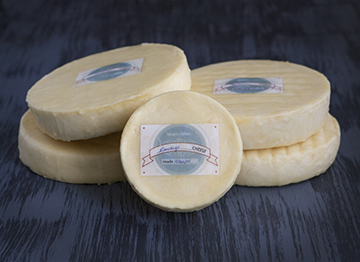
In the book, the brined cheese are brined, patted dry, and then aged. During aging they form a rind. Lately, we have found that it is super-convenient to wax brined cheeses. Waxed Parmesan, Asiago, Gruyere, and Manchego are creamy and delicious. Better yet, there is no hard rind to contend with, which makes the wheels easier to cut and creates less waste, allowing us enjoy even more of our delicious dairy concoctions. As an added bonus, we're able to cut into wheels here and there, re-wax them, and age the remaining portions longer for stronger flavor.
If you decide you want, say, your Parmesan shreds to be super dry like store-bought Parmesan, just pop them into a food dehydrator for a few hours. But grating Parmesan while it's still moist is a whole lot easier than grating an already dry wheel of Parmesan. The flavor of moist Parmesan for things like sandwich slices is divine! |
| 11 L A T E S T R E P L I E S (Newest First) |
| txbikergirl |
Posted - Jan 02 2017 : 04:27:12 AM
my mouth is watering at the thought of manchego |
| maryjane |
Posted - Jan 01 2017 : 2:16:47 PM
You are most welcome! Happy Moo Year to you and yours, too. |
| GingerBKelly |
Posted - Jan 01 2017 : 2:02:01 PM
Thank you, Mary Jane. Your instructions are very thorough and exactly what I need to get this job done well. I love the photos. Thanks and you and your family, enjoy a wonderful moo year! |
| maryjane |
Posted - Jan 01 2017 : 08:46:56 AM
There isn't any test other that it's dry on the outside. The last thing you'd want to do is poke a contaminant into it. Here are my wheels this morning. You can see where some moisture has oozed out in a couple of places. My naked eye can see shiny moisture but the camera doesn't capture that very well. See the little eruption (pimple) on the top? I'll knock that off and continue to dry.
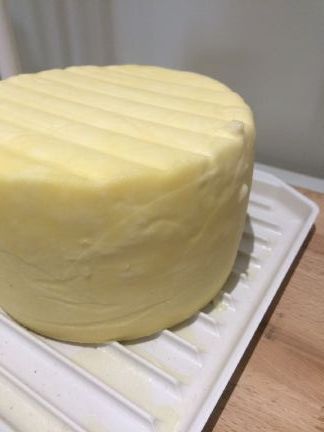
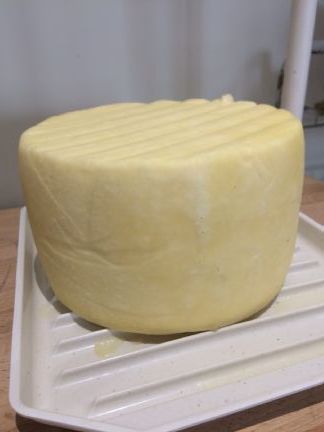
When you wax it, hold the wheel wearing gloves. Melt your wax in a dedicated double boiler set-up along with a dedicated pastry brush or paint brush (expensive, good quality makes a difference so that the hairs stay in the brush). When done, cover the unused wax in the container with a good cover as well as the brush--you don't want dust on either. |
| GingerBKelly |
Posted - Jan 01 2017 : 08:27:32 AM
This is awesome! Thank you for the pictures. Ken and I just read your post and looked at all of this. We will be perfecting our cheese-making skills using this good info. Thank you, again.
Is there some sort of easy peasy test to insure that the cheese is dry enough, but not too dry before waxing, sort of like the toothpick test to insure cakes are finished cooking? If not, what do they feel like, assuming I would have to take the gloves off my hands to test. |
| maryjane |
Posted - Dec 31 2016 : 4:56:44 PM
You can never have too much Manchego. Yours look great. We like our Manchego best after it's been aged a year--super sharp but divine.
I dry my wheels for 3 to 4 days, but then I do double batches, 4 gallons of whole milk per mold. Here's my set up right now. You can see I have this particular floor fan set quite a ways away because even the low setting is too strong.
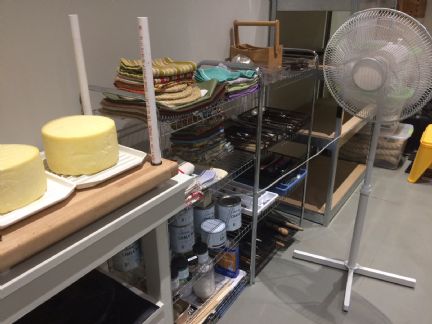
I continue to turn the wheels during that time. Once you've turned them and they're no longer wet on the bottom, dry them for one more day or until they're no longer wet anywhere. (Wax won't stick to anything wet.) In this photo, mine have been drying since this morning. Were I to turn them right now, the bottom would be wet, even though I've turned them a couple of times today. And I almost always have a bit of weeping out the sides during the next couple of days.
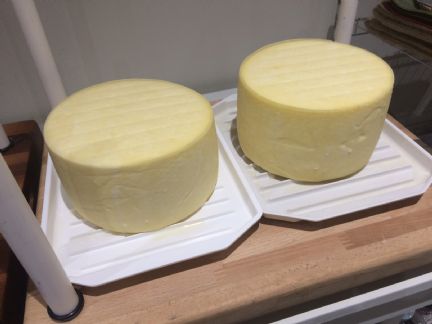
Here's the smaller fan I use when I dry them on our kitchen counter. We can't dry our cheeses in the same room we're making sourdough breads, which is why they're being dried in our prop room today.
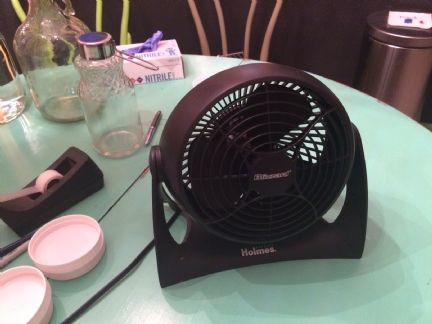
And yes, we still keep the humidity where it should be in our refrigerator cheese cellars by keeping a few jars of water in them. |
| GingerBKelly |
Posted - Dec 31 2016 : 12:29:44 PM
Wonderful...artisan and homemade, these words are absolutely perfect! It's all about perception, right? You are so clever Mary Jane.
Now, we are drying our cheese in the cold room with the fan on. Hopefully, tomorrow or Monday I will wax the cheese. How will I know whether or not they are dry enough? I handle them with clean gloves on.
Also, will I still need to keep a high humidity level (about 70%) in the cheese cellar, once they are waxed? Right now, we have our four little cheeses in the cold room/spare room that hovers very nicely right now, around 50-55 degrees Fahrenheit and will stay that way for 2 to 3 months. We keep our potatoes, pumpkins, beets, carrots and other things like bees wax and canned goods in this room.
Oh lookie lookie! We had so much fun making two wheels of Manchego cheese that yesterday, we decided to make two more. They look very "artisan" if I do say so, myself.  I tried a tiny little sliver of cheese. They taste wonderful. This is very exciting, indeed. I tried a tiny little sliver of cheese. They taste wonderful. This is very exciting, indeed.
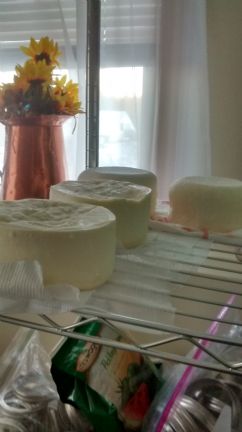
|
| maryjane |
Posted - Dec 30 2016 : 12:07:53 PM
We've never cut ours after pressing, even if the wheels were uneven. The inside texture would be different than the cheesecloth imprint on the outside of the wheel made during pressing. Ours also have the imprint of the grid on the microwave trays we use during drying; we just wax over them.
You could try it. I'm never willing to be rid of any cheese than can be aged and made yummier. I suppose you could pop what you cut off into your mouth. A better word for "slight imperfections" would be "artisan" or "homemade." |
| GingerBKelly |
Posted - Dec 30 2016 : 11:45:36 AM
This is great advise, Mary Jane. I will do this and wax my cheese after a few days of drying. Also, I'd like to ask, before I wax my cheese, can I level off any small imperfections like the top, which may be a little uneven. I would use a very clean stainless knife. Would this work or should I just leave it slightly imperfect? |
| maryjane |
Posted - Dec 30 2016 : 09:01:40 AM
You can wax any hard cheese if you choose. Make sure you dry it first for a few days in front of a small fan set on low and turn your wheel at least a couple of times/day with either gloved hands or very clean hands.
It you don't turn it enough or your fan is set too high, the top half of the wheel dries out faster than the bottom half and the moisture in the bottom half will either cause a split in the bottom on one of the sides or your wheel will become bell-shaped. Dry it thoroughly first all the way around and on both bottom and top, then wax it.
Afterward, you must check your cellar every week to make sure a breech hasn't occurred in the wax allowing for mold to get started around the crack. If that happens, cut off the wax and subsequent mold and re-wax that area. It never hurts to dab a bit of brine on the area, but if you do that you have to wait until it dries to wax.
|
| GingerBKelly |
Posted - Dec 30 2016 : 07:42:22 AM
Thanks, Ashley. I was wondering if I could wax Manchego cheese after it was brined and dried because this step of waxing Manchego wasn't "specifically" mentioned in the Milk Cow Kitchen book, under the Manchego recipe, like a few other cheeses in the prior text of the book. |
|
|
![[flourish]](/images/flourish-txt_mobius.png)
![[flourish]](/images/flourish-txt_mobius.png)